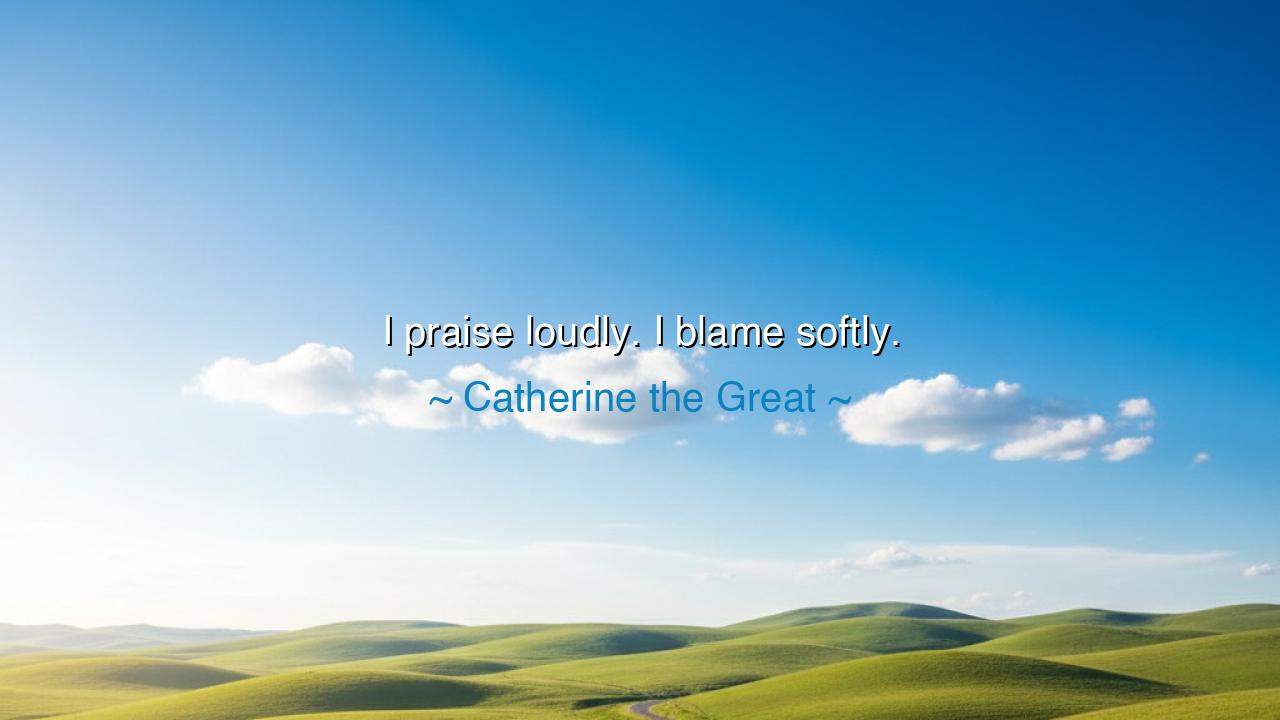
I praise loudly. I blame softly.






O Seekers of Leadership and Wisdom, listen to the words of Catherine the Great, whose reign brought an era of enlightenment to Russia: "I praise loudly. I blame softly." In this simple yet powerful declaration, Catherine reveals the true nature of effective leadership. She understood that the art of leadership is not only in the exercise of power, but in the way one influences others through encouragement and correction. To praise loudly is to lift others up, to inspire them to reach higher and do better. But to blame softly is to correct, not with harshness, but with compassion and understanding, so that the soul is not crushed under the weight of criticism.
Consider, O Children, that praise is a tool that nourishes the soul, a force that builds confidence and encourages growth. When a leader offers praise openly and sincerely, they unlock the potential in others, urging them to strive for greatness. But praise must not be empty or exaggerated. It must be given when it is deserved, and it must come from the heart. The praise of a wise ruler is a beacon, showing the way forward and reaffirming the value of the work done.
Look to the example of Catherine herself, who ruled with an unwavering sense of vision. She fostered culture and education, encouraging the arts and sciences in a way that left a lasting legacy. However, she also knew that greatness cannot be achieved without growth—and growth often comes through gentle correction. In her reign, Catherine was known to offer gentle criticism when her courtiers or officials faltered, guiding them back onto the right path without degrading their dignity. She recognized that the path to true greatness is paved with both encouragement and humility.
And so, O Seekers, let us understand that leadership is an art, and like any great art, it requires both the brush of praise and the hand of gentle correction. Too often, the leader is quick to reprimand, to lash out in the heat of the moment, but Catherine teaches us that the wise leader chooses their words carefully. Blame should never be a tool to destroy the spirit of another, but rather a means to help them rise from their mistakes, stronger and more determined than before.
Let us, therefore, follow Catherine the Great’s example, wielding the power of praise with generosity and the strength of blame with gentleness. We must uplift those who strive for greatness, encouraging them with the power of our words, and when correction is necessary, we must offer it in a way that fosters learning, not shame. In this balance, we find the essence of wise leadership, one that builds up the soul while guiding the wayward back to the path of honor and integrity.






PHPham Huyen
Personally, I need mechanics, not just philosophy. Here’s a draft routine—tell me how to sharpen it: 1) When something goes right, broadcast specifics tied to principles and impact. 2) When something goes wrong, schedule a quick 1:1 within 24 hours, use Situation-Behavior-Impact, co-create a two-step fix, and set a date to review. 3) Log both in a private tracker to avoid recency bias. What signals should I watch to confirm it’s working (retention, error rate, trust scores), and what pitfalls to avoid (the “feedback sandwich,” vague asks, no follow-through)?
PLMai Phuong Linh
Recognition economies have side effects. If applause is frequent and public, it can drift toward inflation or favoritism, souring team cohesion. What structures keep praise meaningful? I’m thinking: rotate spotlights, link shout-outs to explicit values, cap the volume, and diversify who nominates whom. Could you propose a lightweight system with metrics—distribution equity, repeat-recipient ratio, and correlation with measurable outcomes—plus safeguards to prevent gaming? I want celebration to motivate broadly, not create a star system with hidden costs.
ATAnh Tu
There’s an ethical edge case: when harm occurs (bullying, safety violations, harassment), soft tones may shield the wrong person. In those moments, discretion can morph into silence. How do we differentiate everyday performance coaching from situations requiring formal escalation, public transparency, or restorative processes? Could you sketch a decision tree: severity, recurrence, power dynamics, risk to others, and evidence thresholds—each mapping to appropriate voice level, audience, and documentation—so kindness never becomes complicity and accountability retains teeth?
TT27 - 9d phan nguyen tan Tu
Culturally, this principle might land very differently. In high-context settings, discreet critique protects face; in low-context environments, indirectness can be read as vagueness. How should a global manager adapt across teams so encouragement travels widely yet accountability remains crisp and fair? I’d love a matrix: context strength vs. power distance vs. directness, with example phrases that keep dignity intact but leave no ambiguity. Also, how do gender norms intersect here—does “soft” correction get discounted when delivered by certain groups?
PDMinh Pham dinh
From a parenting lens, this sounds humane. Still, I’ve seen kids chase applause while tuning out gentle redirection. Do we accidentally tie self-worth to external cheering and blunt the urgency of correction? What would a balanced routine look like—maybe quiet, specific acknowledgment of effort paired with clear limits and consistent consequences? I’m curious about daily micro-habits: how to time praise, which channel (verbal, note, routine) works best, and how to make corrective guidance unmistakable without shame or theatrics.